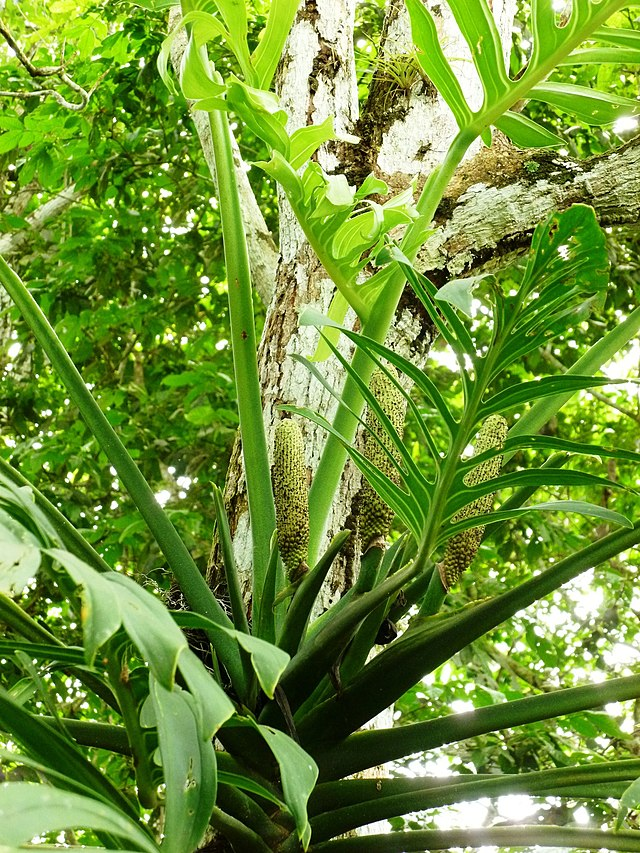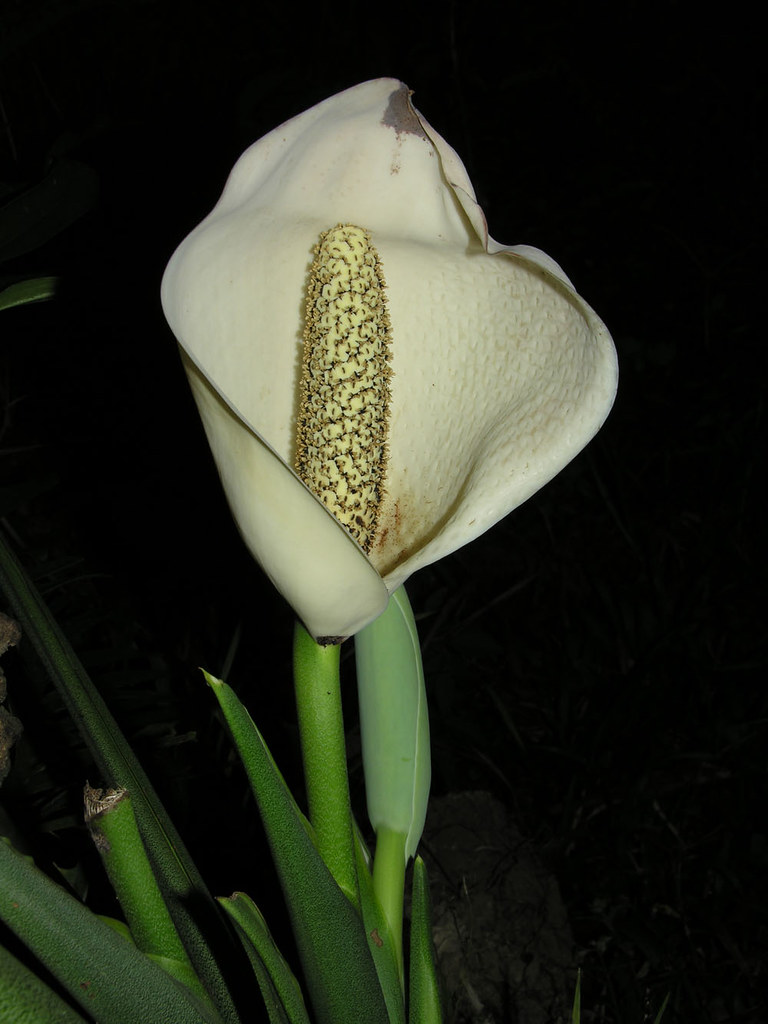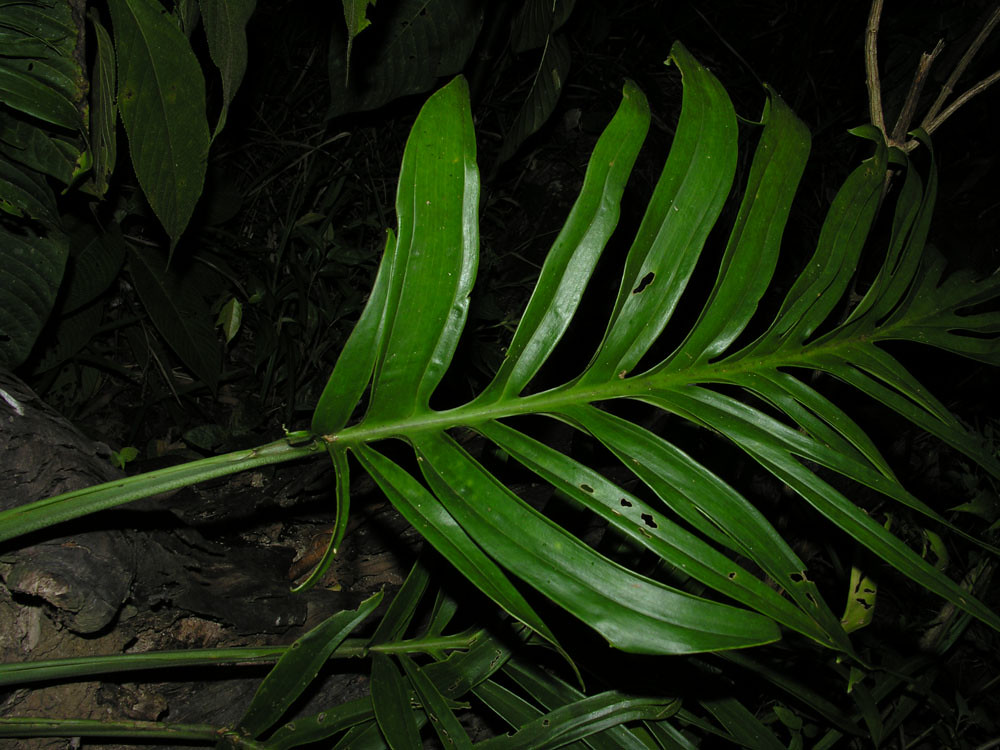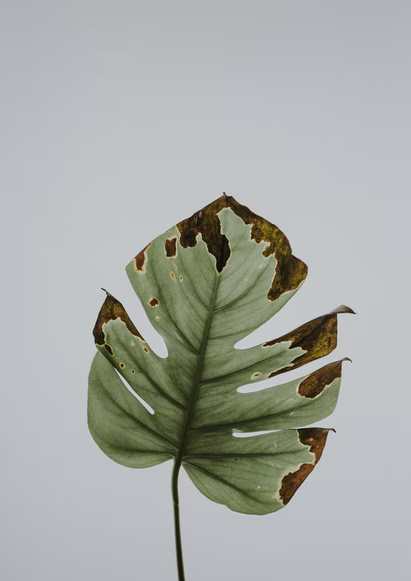Hailing from the rainforests of South America, Ecuador, Colombia, and Peru, a mid-rare tropical plant is gaining traction in the plant community because of its dramatic and equally peculiar characteristics from its juvenile stage to maturity. This plant is the Monstera pinnatipartita, an evergreen climbing species from the Araceae family.
Learn more about this incredible and interesting epiphytic plant below.

Monstera Pinnatipartita Profile
General Information
Monstera pinnatipartita is a somewhat rare species from the genus Monstera. This plant is a close relative to Alocasias and Philodendrons. The Monstera pinnatipartita originates from the tropical South American forests of Ecuador, Peru, and Colombia.
This Monstera is peculiar in the way that the leaf transforms dramatically as the plant matures. The juvenile leaf is different from a mature leaf due to fenestrations or leaf slots and the pinnation as the plant gets bigger. With this transformation, the juvenile stage of the plant is unrecognizable from its mature state.
The unique characteristic of the foliage is that instead of having holes and slots like your Monstera adansonii and Monstera deliciosa, the Pinnatipartita has deep splits that go up to the midrib of the plant. This makes the leaves look similar to feathers.
Etymology
The genus name “monstera” comes from the Latin word “monstrum”, meaning “monstrous” or “abnormal”. This is due to the unusual leaf characteristics of the members of the genus having natural holes and fenestrations.
On the other hand, the species name “pinnatipartita” comes from the Latin words “pinnatum”, which means feather-like, and “partitus”, which means divided into parts. The species name pertains to the unique features of the leaf of this plant. This is why it is also called Split Leaf Philodendron.
RELATED: 13 Types of Monstera To Boost Your Surroundings With Extravagant Greenery
Flowering

The Pinnatipartita Monstera produces an inflorescence called a spadix, consisting of a leaf-like spathe and an anthurium-like spadix. The flowering season of the Monsteras dramatically depends on the location and the environmental conditions.
Season Of Interest And Purchasing
Monstera plants grow actively during the spring and summer seasons. Therefore, it is during these seasons that it is best to buy Monstera pinnatipartita. Commercially, they are available worldwide.
Growth
Monstera pinnatipartita is a medium-growing plant. It grows relatively faster under bright indirect light; however, when in low light, the growth is slowed down. More so, fenestrations and holes are only present when proper light is given to the plants.
Pinnatipartita is a climber, so its growth pattern is upward rather than along the surface. Therefore, a moss or coir pole is recommended to be given to this plant to grow on. It can also creep up a wall, providing a dazzling impact on the ambiance. You can grow Monstera pinnatipartita outdoors and make it a great outdoor plant.
Monstera pinnatipartita Overview
| Scientific name | Monstera pinnatipartita |
| Common name/s | missold as Philodendron Silver Queen |
| Family | Araceae |
| Growth Habit | Herbaceous, Epiphytic Vine |
| Height and Spread | up to 25 meters in height, and 2.5 meters in leaf length |
| Classification based on life cycle | Perennial |
| Origin and Distribution | Originated from South American rainforests |
| Climate Zone | Generally mild climate |
| USDA Plant Hardiness Zone | USDA Zone 10-13 |
| Color | Glabrous and shiny evergreen leaves with prominent fenestrations and deep slits |
Care Tips

Light Requirement
Like any other tropical plant, Monstera pinnatipartita thrives in environments with similar conditions to rain forests. If you are unsure of what’s best for your plant, think of what a forest life gives them and try to emulate it in your own spaces.
Monstera plants like bright indirect sunlight. In the wild, it climbs on trees to get a hefty amount of brighter light at the top. If you like them to grow tall fast, duplicate this environment and let them grow under this light condition. However, always avoid direct sunlight as it will burn their foliage and gives you crispy edges.
Your Pinnatipartita can tolerate low light. However, you can notice that it will grow slower, and the leaves are darker with this lighting condition. The slits and perforations on the leaves will also slowly get sparse, so give them the proper amount of quality of light.
Temperature Requirement
As a tropical plant, Monstera pinnatipartita grows best at warmer temperatures. Their optimum temperature ranges from 65-80 degrees Fahrenheit. Although, they are more chill-resistant as compared to other equatorial plants. They can survive to a minimum of 50 degrees Fahrenheit but never below it.
They can be an excellent indoor plant as long as a suitable room temperature is maintained at all times.
Water Requirement
To have a thriving Pinnatipartita, the soil environment must be kept moist but not wet. To achieve this, proper watering techniques and schedules are needed.
As a general rule, water the soil when almost completely dry. Check the top inches of the soil first. If moisture is still present, do not water it yet. This will help you avoid overwatering, which could lead to root rot and the plant’s eventual death. You can water your plant once a week. However, increase it to 2-3 times as needed in summer and spring.
The amount of water depends heavily on your location and the environmental conditions. Therefore, make sure to give your plant the optimum care and attention.
Humidity Requirement
Humidity is essential for tropical plants as they come from rainforests with moderate to high moisture levels. This is because they are exposed to heavy rain in their natural habitat and thrive in a moisture level of 60% and above. So ideally, an environment with high humidity is best for your Monstera pinnatipartita.
However, you can still grow them in average humidity conditions, and they will still thrive. It is best, though, if you increase it. You can do it by putting a humidifier or growing along with other plants such as Philodendrons and Pothos to create a huddling environment. Grouping plants together will allow humidity to increase.
Soil Requirement
Monstera pinnatipartita, as an epiphyte, can grow without having roots in the soil. Instead, they creep over trees to gather nutrients from the air and other decaying organic matter such as animal droppings or dead leaves.
The ideal soil mix for your plants includes plenty of organic matter like bark bits, compost, mulch, and organic manure like animal dung. A 50/50 ratio of these materials and sandy potting soil could do wonders for your plant. This potting mix is well-draining and high in nutrition.
Commercially available Anthurium or Aroid potting mix is also good for your plants.
RELATED: A Yellow Nightmare: 7 Reasons Why Your Monstera Plant Is Changing Color
Fertilizer Requirement
Plants do better with complete and adequate nutrition to maintain their healthy growth and development. For Pinnatipartita, decaying organic matter can act as a slow-release organic food for the plant.
You can add a balanced 20-20-20 fertilizer or 20-10-10 to make the plant produce larger and healthier leaves. A fish emulsion that is diluted can also be used.
Feed your plant every 4-6 weeks, especially during spring and summer’s growing season. Cut back on feeding during winters so the plant can take a break. An orchid or anthurium fertilizer available on the market is also suitable for Monstera pinnatipartita.
Space Requirement
The Pinnatipartita has a peculiar growing pattern. It grows tall rather than wide and can go from 30 cm to 6 m in height. In addition, the leaves are medium-sized and have a spread of 30 cm to 2 m. With these growing characteristics, you may need more vertical spaces for this plant to grow beautifully.
Growing And Planting Tips
Propagation
There are many methods to propagate Monstera pinnatipartita. However, stem cutting propagation is the most common method that gives you a high growth success rate. This method can be done using water or planting in the soil directly.
To propagate Monstera pinnatipartita using stems, make sure to choose a branch with at least one node. Pick those with aerial roots if present since they grow into normal roots when in contact with a proper growing medium. Allow the stem cuttings to develop roots for two weeks or more in the desired growing mix.
If you are using soil, mix it with vermiculite and moisten it before putting the cutting. On the other hand, choose a container with a proper size so that the water will cover the node if you are going via water propagation. Retain only two leaves in the stem and place them in a well-lit area.
Pruning
It is recommended to prune the Monstera plant in order to control its height and width. Make sure you use a clean, sharp pair of scissors, better if pruning shears. Then snip off the end of the vine below the node, careful not to cut into the node itself.
Potting And Repotting
The Monstera plant loves to be pot-bound. First, check the drainage holes for roots to know if your plant needs re-potting. If roots are growing out of it, your plant may need a bigger pot.
Before re-potting, make sure to add fresh fertilizer and organic matter to the bottom of the new pot. Tap the plant out of the current pot and then push the root ball firmly into the new pot with soil. Pat down the soil to make sure there aren’t any air pockets. Make sure also that the newly re-potted plant has enough moisture by watering and misting it.
Since your plant is climbing, make sure to re-pot it with a moss pole or a piece of wood or any form of trellis. You can also put the plant near a wall and let it climb on it.
Monstera Pinnatipartita Care
| Light | Bright indirect light, dappled shade |
| Temperature | Intermediate to warm, 65-80 degrees Fahrenheit |
| Water | Once a week, increased in summer, decreased in winter |
| Soil | Airy, well-draining soil; not too loose |
| Fertilization | Regular household fertilizer, once a month |
| Space | Plenty of space to climb |
| Propagation | Via stem cutting propagation |
| Blooming | Rarely blooms, enough sunlight and maturity needed |
| Pruning | Regular pruning |
| Potting | Regular potting mix, use of organic debris, peat, charcoal, perlite and orchid bark is recommended |
Problems And Troubleshooting

Wilting
Wilting may be a result of overwatering or underwatering. When you see your plants wilting, take immediate action by checking the soil’s moisture level. You can do this by using a moisture meter or sticking your finger an inch to two into the soil.
If it is dry, you need to water the plant with demineralized water and mist the leaves. If it is too wet, tap the plant out of the pot onto a paper towel or plastic bag.
Next, inspect the roots for root rot and gently cut them away if there are any. After this, replace the wet soil with fresh, loose dry soil as instructed above.
Diseases
Any plant can be susceptible to diseases if not properly taken care of. Particularly, plants of this family are affected by Septoria Leaf Spot and Alternaria Leaf Spot, resulting in fungal growth. Usually, these are also due to over-watering the plants.
Take action immediately when you see yellowing (Septoria) or brown spots (Alternaria). You can treat your plants with a copper-based fungicide, and make sure to be attentive to the watering conditions for it not to happen again.
Pests
Unfortunately, the Monstera plant is also not resistant to common pests. Common pests include fungus gnats, aphids, spider mites, and thrips. They usually show up when the plant is exposed to other infected plants or if the plant is stressed from neglect or improper care. Yes, these pests can smell the plant’s stress!
To look for signs of insects and their activities:
- Check carefully your plant’s leaves, undersurfaces, stems, fertilizers, and roots.
- When you see any pests on leaves, wash them off with a damp sponge. If you see pests on the stems, use soapy water.
- If there are pests in the soil, treat them with neem oil or any other natural pesticide or insecticidal soap.
- Check also for the surrounding plants to avoid further infection.
Monstera Pinnatipartita Pests And Diseases
| Common Pests/Diseases | Symptoms | Treatment and Prevention |
Common diseases include crown rot, stem rot, root rot, leaf spot, fungal diseases, and Xanthomonas infection | Yellowish rimming around black or dark brown spots on leaves | Avoid overwatering. Keep soil dry. Avoid too high humidity.Proper ventilation is needed around the plant. Remove infected parts of fungal infections to avoid spreading |
| Common pests include mealybugs, spider mites, aphids, and scales | Visible insects on the surface | Spray plant with warm, soapy water. If infestation is present, use insecticide or neem oil. Use diatomaceous earth. |
Problems With People And Animals
Toxicity
Monstera pinnatipartita contains calcium oxalate crystals in its stems and leaves like all Aroid. These crystals are toxic when ingested and cause irritation and swelling to the throat.
In severe conditions, it could block the air passage, causing difficulty in breathing and swallowing. It can even lead to death in the worst situations. So it is crucial to keep them out of your children and pets.
Monstera Plants Meaning And Symbolism
Monsteras symbolize long life and honor and respect for elders and respected people. Therefore, they would make an ideal gift for the elderly and people we owe respect to. More so, in the language of flowers, the inflorescences of Monsteras represent grandiose plans, deep relationships, and glad tidings.
However, in some cultures around the world, the clingy aerial root systems and vine habit may symbolize suffocation.
| General Meaning | Longevity of life, flowers – grandiose plans, deep relationships, glad tidings |
| Symbolism | Honor and respect for elders and respectable people, suffocation |
Landscaping And Gardening Ideas
Companion Plants
Other tropical plants go well with Monsteras, especially Philodendrons and other Aroids. Some of the plants you may consider include bird of paradise, areca palms, fire spike, heliconia, variegated arboricola, croton, chenille plant, and pentas.
Some of these plants will have additional colors and hues of warm oranges and reds, which will perfectly complement your cool dark greens.
Landscaping Ideas
Monsteras go well as accents inside a humid room or a cozy deck or patio. A full plant can also be placed in the corner of the house or along the entryway.
Outdoors, it can be a filler plant for a garden corner, in between palm trunks, or under tall trees. It can also be placed near pools to add even more tropical vibes as long as it won’t get splashed at.
Monsteras are also good wall accents since they creep up walls and offer a unique, vibrant living wall in your urban space.
| What to plant with | Other Aroids, Bird of Paradise, Areca Palms, Fire Spike, Heliconia, Variegated Arboricola, Croton, Chenille Plant, Pentas |
| What NOT to plant with | Basically nothing |
Conclusion

The Monstera pinnatipartita, often missold as Philodendron Silver Queen, has gained popularity with gardeners over the years. The unique foliage filled with deep slits and fenestrations offers an abstract and eye-catching focal point in any spaces they are in. They are medium-growing plants and easy to care for; they are perfect for beginners who really cherish the aesthetic values of plants.
Frequently Asked Questions
Is Monstera pinnatipartita a fast grower?
The Pinnatipartita plant is a medium-grower. Its growth rate depends on the light conditions it receives. If your plant receives a good amount of bright indirect light, it will surely actively grow. However, if it is placed in a darker environment, your plant will grow slowly and will lose its fenestrations and holes.
How do you propagate Pinnatipartita?
The Monsteras are easy to propagate. They can be propagated using stem cuttings. Choose a stem with at least one node. If aerial roots are present, then that is a perfect choice. Dip the cutting into a proper growing medium and wait for the roots to grow extensively.
Is Monstera pinnatipartita a rare plant?
The Monstera pinnatipartita is somewhat a rare plant. Although, with the advent of tissue culture cultivation, the plant’s availability in the market has improved.
Is Monstera pinnatipartita hard to grow?
Definitely not. Monsteras are relatively easy to grow and care for. They can thrive in a suitable room condition provided that the optimum care and attention are given. Beginners can grow this plant.
Does Monstera pinnatipartita go dormant?
No. Monstera plants do not go into dormancy because they do not produce bulbs or storage organs that plants utilize during the winter season for energy and sustenance, like your Alocasias and other Lilies.
Do you have tips on how to take care of Monstera pinnatipartita? Share it with us, comment below. Also, read our other articles:
Hoya Krimson Queen: The #1 Most Informative Care, Propagation, and Watering Guide







